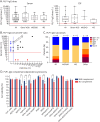Conformational Antibodies to Proteolipid Protein-1 and Its Peripheral Isoform DM20 in Patients With CNS Autoimmune Demyelinating Disorders
- PMID: 39823554
- PMCID: PMC11744608
- DOI: 10.1212/NXI.0000000000200359
Conformational Antibodies to Proteolipid Protein-1 and Its Peripheral Isoform DM20 in Patients With CNS Autoimmune Demyelinating Disorders
Erratum in
-
Conformational Antibodies to Proteolipid Protein-1 and Its Peripheral Isoform DM20 in Patients With CNS Autoimmune Demyelinating Disorders.Neurol Neuroimmunol Neuroinflamm. 2025 May;12(3):e200389. doi: 10.1212/NXI.0000000000200389. Epub 2025 Mar 21. Neurol Neuroimmunol Neuroinflamm. 2025. PMID: 40117521 Free PMC article. No abstract available.
Abstract
Background and objectives: Antibodies to proteolipid protein-1 (PLP1-IgG), a major central myelin protein also expressed in the peripheral nervous system (PNS) as the isoform DM20, have been previously identified mostly in patients with multiple sclerosis (MS), with unclear clinical implications. However, most studies relied on nonconformational immunoassays and included few patients with non-MS CNS autoimmune demyelinating disorders (ADDs). We aimed to investigate conformational PLP1-IgG in the whole ADD spectrum.
Methods: We devised a new live cell-based assay (CBA) for PLP1-IgG and used it to test 2 cohorts (retrospective exploratory, n = 284; prospective validation, n = 824) of patients with ADDs and controls (n = 177). Patients were classified as MS, neuromyelitis optica spectrum disorders (NMOSDs), myelin oligodendrocyte glycoprotein antibody-associated disease (MOGAD), and other ADDs. PLP1-IgG-positive samples were tested for IgG subclasses, DM20-IgG, and on rat brain tissue-based assay (TBA). Complement-dependent cytotoxicity (CDC) was assessed on a live CBA and antigen specificity and conformational binding through immunoadsorption/colocalization/fixation experiments.
Results: PLP1-IgG were found in 0 of 177 controls and 42 of 1104 patients with ADDs mainly diagnosed as other ADDs (19/42) with frequent myelitis/encephalomyelitis (14/19) and coexisting PNS involvement (13/19). Four of 19 patients with other ADDs fulfilled the seronegative NMOSD criteria. PLP1-IgG were also found in patients with MOGAD (11/42), more frequently with PNS involvement (p = 0.01), and in patients with MS (12/42), more frequently with atypical features (p < 0.001). PLP1-IgG-positive MOGAD had higher EDSS scores (p < 0.001) and PLP1-IgG-positive MS had higher severity scores (MSSS, p < 0.001) compared with those PLP1-IgG-negative. Overall, PLP1-IgG were found in 24.1% of patients with CNS+PNS-ADD, 21.2% with atypical MS, 8.3% with MOGAD, 12.0% with seronegative NMOSD, and 1.4% with typical MS. Their frequency within each diagnostic subgroup was consistent between the exploratory and validation cohorts. PLP1-IgG a) colocalized with their target on CBA-TBA, where their binding was abolished after immunoadsorption and fixation-induced conformational epitope alteration; b) mostly pertained to the IgG1/IgG3 subclass (68.3%) and were able to induce CDC; and c) coreacted with DM20 in all 12 patients with PNS involvement tested.
Discussion: Conformational PLP1-IgG predominantly identify patients with non-MS ADDs. They should be tested mainly in those with CNS + PNS ADD, coherently with DM20-IgG coreactivity. PLP1-IgG could also be investigated as disease modifiers and prognostic markers in MS and MOGAD. Preliminary evidence supports their pathogenic potential.
Conflict of interest statement
M. Gastaldi received compensation for speaking activities and/or consulting services, from Alexion, UCB, and Roche; he is the MG is the co-beneficiary of a patent on the PLP1 CBA currently under evaluation from the UIBIM (IT n. 102023000005046). Prof. M. Filippi is Editor-in-Chief of the Journal of Neurology; Associate Editor of Human Brain Mapping, Neurological Sciences, and Radiology; he received compensation for consulting services from Alexion, Almirall, Biogen, Horizon, Merck, Novartis, Roche, Sanofi; speaking activities from Bayer, Biogen, Celgene, Chiesi Italia SpA, Eli Lilly, Genzyme, Horizon, Janssen, Merck-Serono, Neopharmed Gentili, Novartis, Novo Nordisk, Roche, Sanofi, Takeda, and TEVA; participation in Advisory Boards for Alexion, Biogen, Bristol-Myers Squibb, Horizon, Merck, Novartis, Roche, Sanofi, Sanofi-Aventis, Sanofi-Genzyme, Takeda; scientific direction of educational events for Biogen, Merck, Roche, Celgene, Bristol-Myers Squibb, Lilly, Novartis, Sanofi-Genzyme; he receives research support from Biogen Idec, Merck-Serono, Novartis, Roche, Italian Ministry of Health, Fondazione Italiana Sclerosi Multipla, and ARiSLA (Fondazione Italiana di Ricerca per la SLA). C. Zanetta received compensation for speaking activities, and/or consulting services, from Alexion, Astrazeneca, Biogen, Bristol Myers Squibb, Janssen, Merck, Novartis, Roche, Sandoz, and Sanofi. R. Lanzillo received personal compensations for speaking or consultancy from Biogen, Alexion, Sanofi, Merck, Bristol Myer Squibb, Jansenn, Novartis, Amgen and Roche. The remaining authors report no disclosures. Go to
Figures





References
MeSH terms
Substances
LinkOut - more resources
Full Text Sources
Research Materials
